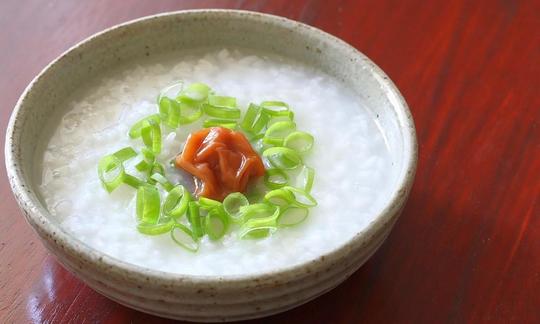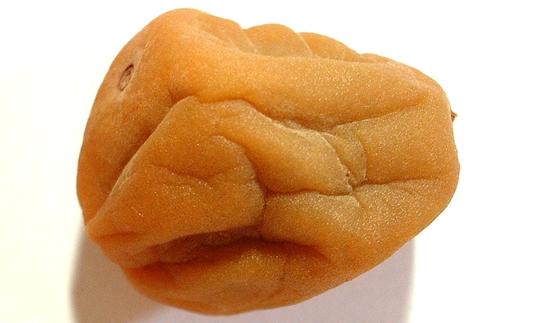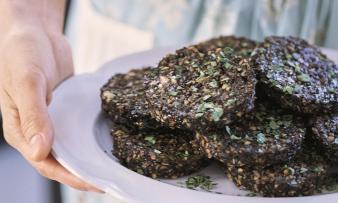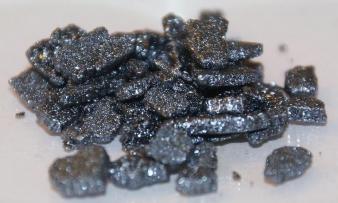Umeboshi paste (Japanese: Neriume, Neri ume) is also known as Bainiku.
Use in the kitchen:
Umeboshi paste tastes sophisticated and spicy thanks to a combination of sour (mainly due to the citric acid) and salty. It is often used in salad dressings, dips, sushi rolls, soups, tofu and vegetable dishes or as a spread. Due to their intense aroma, both the paste and the pickled ume fruits should be used in small quantities at first and the amount increased if necessary after tasting. In Japan, umeboshi is also often eaten with rice or used in green tea.
| Not only vegans or vegetarians should read this: Vegans often eat unhealthily. Avoidable nutritional errors. |
Purchasing
Umeboshi paste is usually available in Asian shops, sealed in a plastic bag. It is also often sold in health food stores, drugstores, or you can buy it online. A Japanese company produces good organic quality umeboshi paste, which is often available in organic shops. It is also available as a concentrate or whole fruit, which you can puree yourself to make a paste.
Traditional production:
The Ume fruits are harvested when they are still green. After cleaning, they are mixed with salt and placed in large wooden vats. During production, the salt content must be between 12 and 25% in order to achieve lactic acid fermentation. This process is comparable to sauerkraut production. The salt extracts the water from the Japanese apricots. With the help of a weighted lid, the fruits remain below the liquid level, which presses additional water out of the fruits. The anaerobic state causes lactic acid fermentation to begin and lasts about 1 - 2 months. The fruits are then dried outdoors for 4 - 7 days, depending on the weather. The fruits are now white in color. They are also available in this form as "Shiroboshi". The remaining salted fruits are soaked with shiso leaves in the umeboshi broth. After a week of soaking, the fruits are removed and layered in barrels together with the shiso leaves. There they continue to ripen for another 1 - 2 years. During this time the umeboshi take on the red to brownish color of the purple shiso leaves. 1
Modern production
Umeboshi paste is basically made from salt-preserved ume fruits, the umeboshi, as well as purple shiso leaves and sea salt by means of fermentation.
Most modern umeboshi is made by using less salt and soaking it in already seasoned liquid or vinegar. Typically, they are colored red using purple perilla leaves (akajiso) or flavored with katsuobushi (bonito flakes), kombu or sweetened, ideally with honey. Since modern preservation methods use less salt, umeboshi usually contain an artificial preservative to extend their shelf life. 3
Ingredients:
Umeboshi paste contains a very high salt content due to the way it is prepared, which is why it is not used in large quantities. Umeboshi generally contains vitamin A, potassium, copper, iron and calcium. Umiboshi fruits also contain organic acids such as phosphoric and citric acid. Picric acid and catechinic acid help the liver and intestines stay healthy. You can find more information about the ingredients at the bottom after the text in the nutrient tables.
Health aspects:
The antibacterial effect of umeboshi has been proven in studies. This effect relates to certain strains of bacteria in cases of food poisoning. 7 Umeboshi is particularly recommended for diarrhea and dysentery. Its effect is said to be better than Pepto-Bismol, for example. 4 Its salty, sour taste also helps with sore throats. The effect of umeboshi is often compared to Alka-Seltzer (acetylsalicylic acid), but without side effects. 5,6 When used as a medicine, umeboshi is often combined with kudzu, a legume, or bancha tea, a type of green tea. 1
In traditional Chinese medicine (TCM), umeboshi is known as "wu mei". Women use umeboshi to treat morning sickness, menstrual cramps and hormonal disorders. To do this, you regularly dissolve half a teaspoon of umeboshi paste with a little honey in a cup of hot water and drink it.
Umeboshi is said to have a detoxifying effect, which is why it is known as a weight-loss product. The fruit is also very alkaline and counteracts over-acidification of the body. It helps to maintain a slightly alkaline pH value in the blood. A combination with green tea is also suitable for this.
The preparation of umeboshi and umeboshi paste has been culturally anchored in Japan for many centuries and, in addition to being used as food, umeboshi also serve as an effective natural remedy.
Occurrence:
Ume ( Prunus mume), the Asian tree, originally comes from China, but has long been known in Japan and on the Korean peninsula. There are a few very old trees that are up to a thousand years old. In German-speaking countries, Ume is known as Japanese apricot or Japanese plum. Since the Ume belongs botanically to the rose family, it is more closely related to apricots than to plums. 2
Cultivation and harvest
The main growing areas are Japan, Korea, the USA, South America, South Africa, Spain and Italy. The fruits are harvested from June when they are green. They change colour as they ripen, from deep red to yellow to dark blue, depending on the variety. They resemble large mirabelle plums or smooth-skinned apricots. The flesh of the ripe fruits is yellow. Because they are very soft and sensitive, they are considered difficult to transport and are increasingly sold preserved or processed.
General information:
Umeboshi (Japanese 梅干, from ume 梅 = plum, boshi < hoshi < hosu 干 = dry) is known in German as "salted plums". 1
In addition to using the whole fruit, you can find the paste (Bainiku) or powder, which is created after roasting on charcoal. Honey is traditionally used as a sweetener for the sweet umeboshi variant. It is also suitable as a side dish with rice or as rice balls (including the fruit core) for breakfast or lunch. Ume Su, a type of seasoning sauce or mild vinegar, is created as a by-product when salting ume to make umeboshi. Ume Su is used in salad dressings, stews, vegetable stir-fries, like vinegar, only no salt is needed.
The ume tree is highly valued, especially in Japanese and Chinese culture, art and poetry. Its unusual flowering period is particularly special: it blooms in the coldest time of the year, from January to February, and was even more popular than the cherry blossom during the Nara period (710-794). 8 The ume is considered a symbol of vitality, resilience and the will to survive, and is said to bring good luck.
The importance of the ume in Japan is comparable to that of the apple in Central Europe.
Literature / Sources:
- German Wikipedia. Umeboshi.
- German Wikipedia. Ume.
- English Wikipedia. Umeboshi.
- Kramer SW. The Naturally Healthy Traveler. 2nd edition. Lotus Press: 2012. ISBN 978-0-9409-8504-9.
- Pitchford P. Healing with Whole Foods: Asian Traditions and Modern Nutrition. 3rd edition. North Atlantic Books: 2002. ISBN 978-155643-471-6.
- Skinner M, Hunter D. Bioactives in Fruit: Health Benefits and Functional Foods. John Wiley & Sons: 2013. ISBN 978-1-118-63559-9.
- Yang DJ, Chen HY, Liu SC. Study of the Antibacterial Efficacy of Bainiku-Ekisu against Pathogens. International Journal of Bacteriology. 2014. doi: 10.1155/2014/460395.
- Conan M, Kress WJ. Botanical Progress, Horticultural Innovation and Cultural Changes. Harvard University Press. 2007. ISBN 978-0-88402-327-2.











Comments